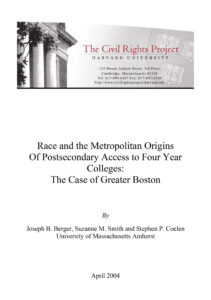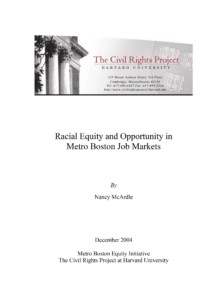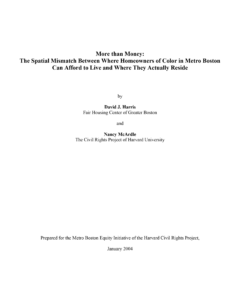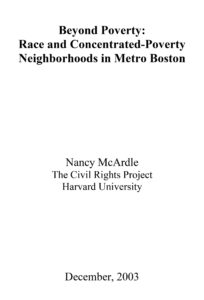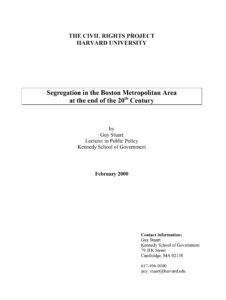Executive Summary
In their analysis of the sources of urban riots in the mid-1960’s the National Commission on Civil Disorders observed that the country was dividing into two nations, increasingly separate and unequal. Now several decades later and in a very different social and political climate, Census 2000 reminds us that divisions remain very deep. Analyses have shown that reductions in black-white segregation have been slow and uneven. New minorities have become much more visible since the 1960s, and while Hispanics and Asians are less segregated than are blacks from whites, their levels of segregation have been unchanged or rising since 1980.
Separate neighborhoods also continue to be unequal. One of the major costs of residential segregation is that minorities live in poorer neighborhoods with less resources than do whites with comparable incomes. Analysis of the Boston metropolitan region reveals that this national pattern persists here despite a decade of widespread prosperity, and we find that disparities are experienced most strongly by children.
We look at children’s experiences in the neighborhoods where they live (how separate? how unequal?) and the schools that they attend. These are both important to child development, but we believe schools have a particular importance because of how they affect children’s chances for achievement in their adult lives. We also look very closely at differences within the metropolis between the City of Boston, other smaller cities, and suburbs. It turns out that the exclusion of minority children from suburban neighborhoods and schools is the most significant key to racial inequality in the Boston region.
This study shows:
- Black and Hispanic children are highly segregated in the neighborhoods where they live. They also live in unequal neighborhoods, as measured by neighborhoods’ income levels, poverty rate, unemployment, homeownership, and other indicators.
- Neighborhood segregation is especially high in the City of Boston. But seen from a regional perspective, the main source of segregation is minorities’ exclusion from most residential suburbs. Less than 10% of children under 18 in the Boston region lived in the City of Boston in 2000. But nearly half of black children lived in the City. A small set of older, denser suburbs (including such places as Lynn, Lowell, Chelsea, Lawrence, and Worcester) house a majority of Hispanic children.
- School segregation is lower in Boston than in other portions of the region. This reflects the history of desegregation efforts in the City, despite erosion of these gains in the last decade. But again, the main source of segregation in the region is the exclusion of minority children from schools in the residential suburbs. Only 25-30% of black and Hispanic children in public elementary grades attend schools in these districts, compared to 85% of white children and more than half of Asian children.
- As a result, black and Hispanic students also attend unequal schools, compared to white and Asian students, as measured by the concentration of poor children in their elementary schools.
The Metro Boston Equity Initiative is devoted to analyzing race relations and racial equity issues not simply in the city of Boston, but across the entire metropolitan region. Although greater Boston still has a large white majority and suburban sectors with very little diversity, immigration of Latinos and Asians is driving the region’s growth, and much of this population increase is taking place well outside of the city limits.
In compliance with the UC Open Access Policy, this report has been made available on eScholarship:


